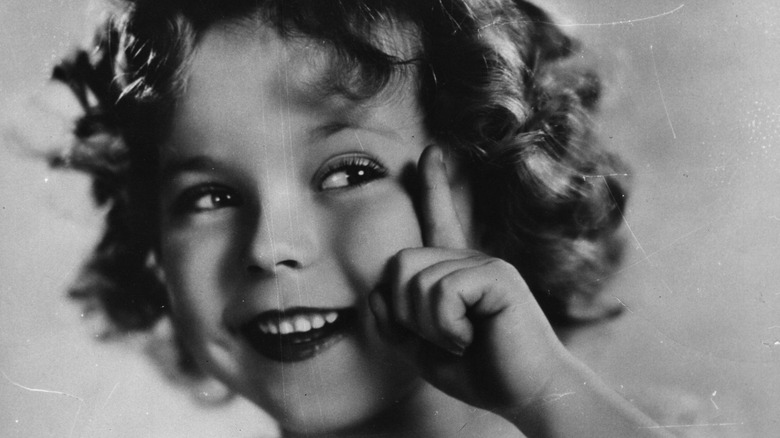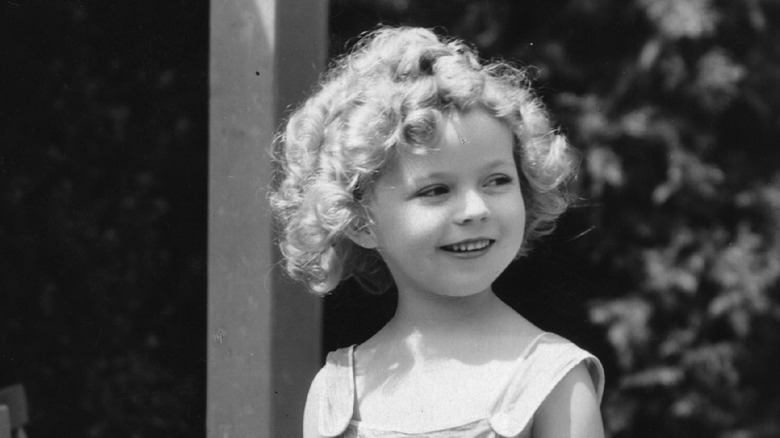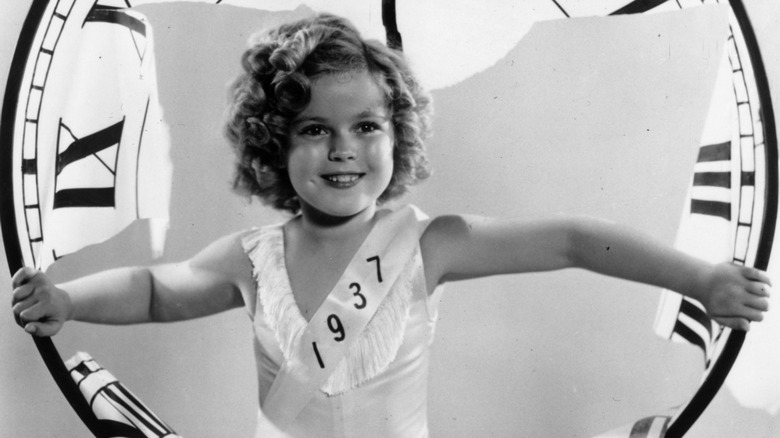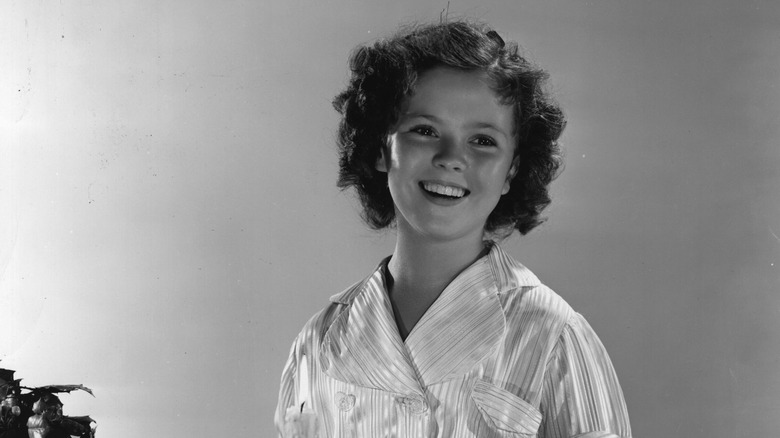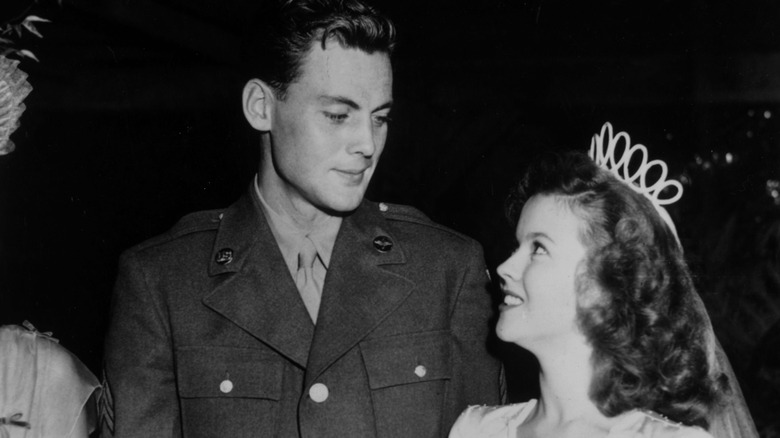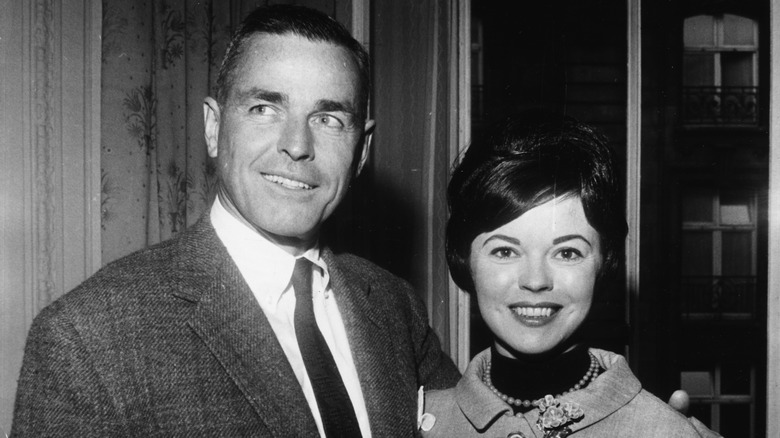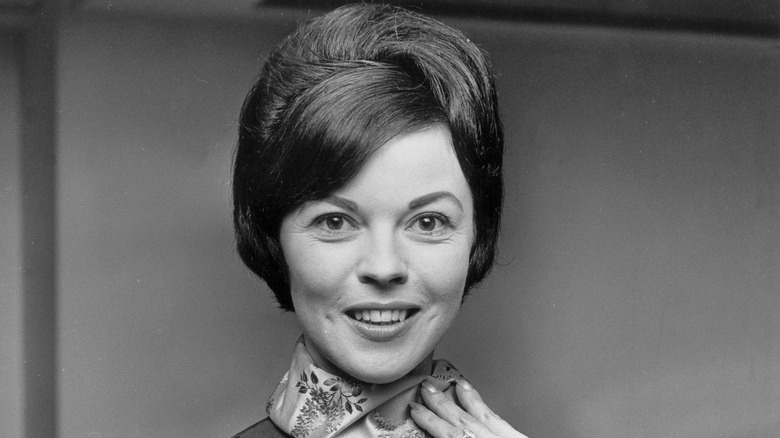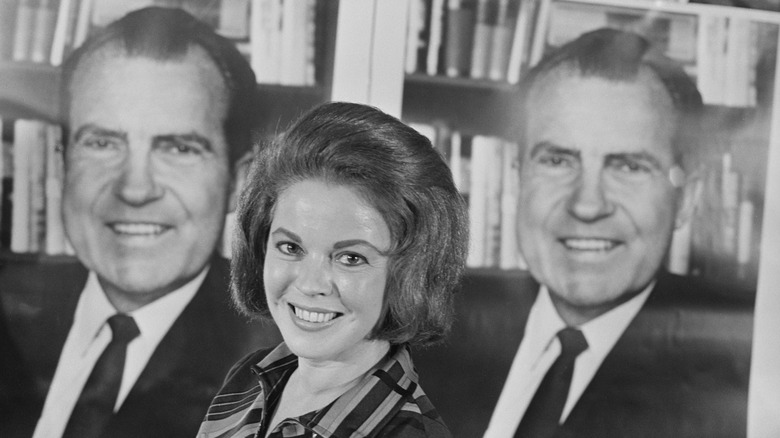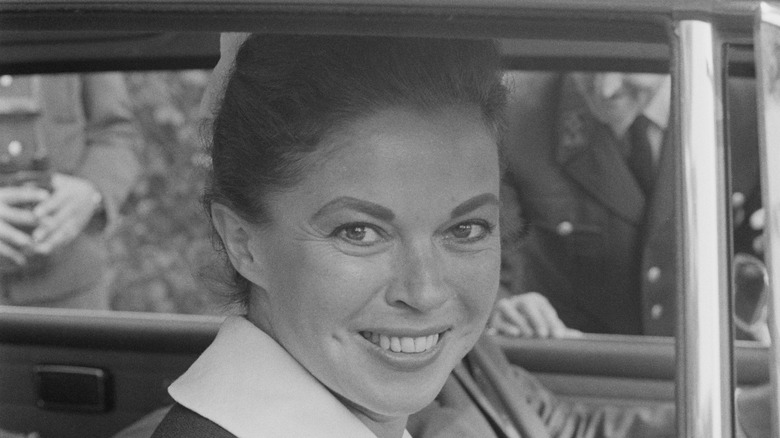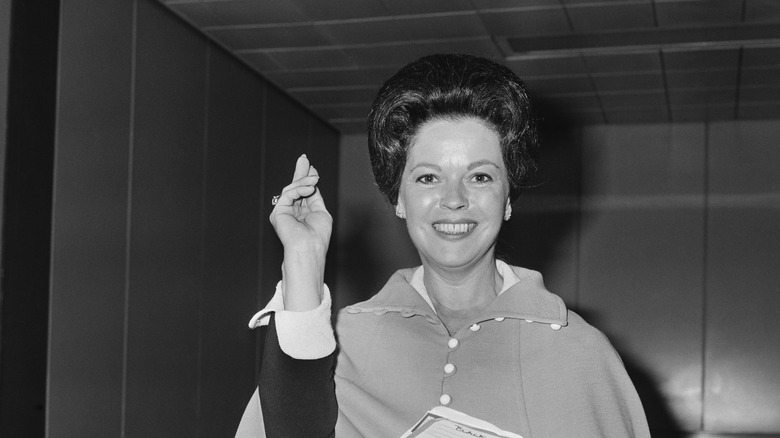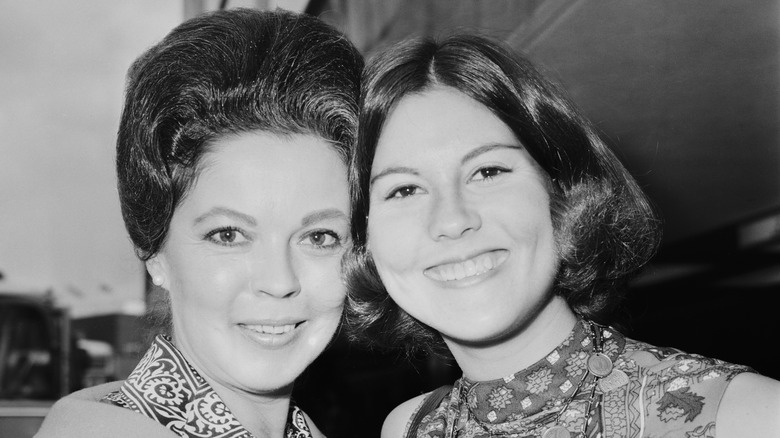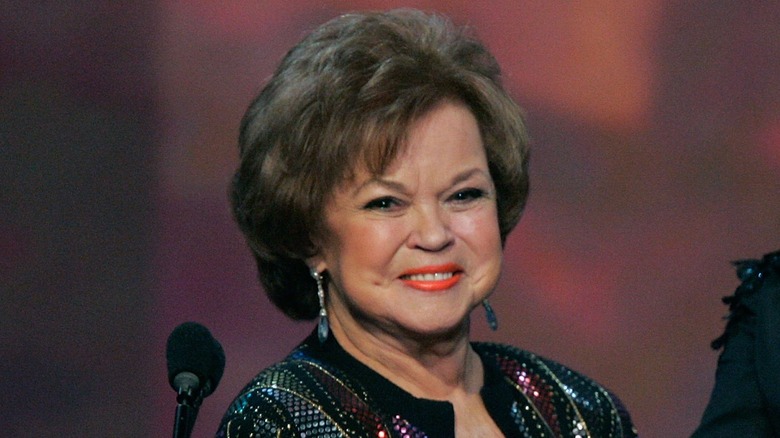The Untold Truth Of Shirley Temple
For many, Shirley Temple is one of two things: an old-timey child actress with bouncy blonde ringlets or the super sweet non-alcoholic beverage you can order at a bar. While those facts are certainly the ones that stuck, Temple's life involved way more than just grenadine mocktails and cutesy performances.
According to her biography, Temple was born in Santa Monica, California in 1928. Her father was a banker and her mother, like many women of the time, was a stay-at-home mom of two older children. Just one year after Temple's birth, the Great Depression hit the nation. Nevertheless, the Temple family had their youngest daughter enrolled in dance classes when she was a toddler and, after landing a contract with Educational Pictures, the curly-haired little girl became a superstar in a matter of years.
At a time when banks were closing at rapid rates, Temple's father took up work as his daughter's agent and financial advisor. Without their daughter's rapid success, the Temple family may have ended up living a very different life. So, just who was this amazing little girl and what was her life like as an adult? Here's her untold truth.
These were her cringe-worthy first roles
In 1932, Temple, at the age of three, got her first speaking role in the film fittingly titled "War Babies." Temple's character in the film, however, was not exactly an appropriate fit — at all. Temple played an exotic dancer — you can't make this stuff up — for soldiers who were also played by children. It's in that film that Temple gets her first kiss. Eek.
Temple's career continued with a series of equally cringe-worthy short films. As these features were spoofs of popular movies of the time, Temple was again playing a role meant for an adult. As Time reported, the child star would deliver lines like, "I'm expensive" and exchange kisses for lollipops. Equally terrible was the title of the series: "Baby Burlesks."
Temple would later criticize the series in her autobiography, "Child Star," in which she called them "a cynical exploitation of our childish innocence that occasionally were racist or sexist" (via Independent). Sounds about right.
She was the most popular movie star in the U.S. for years
Despite her raunchy and downright weird start, Temple became an incredible success. The New York Times reported that she was the "most popular movie star in America" from 1935 to 1939. To put that into perspective, Clark Gable, who is often referred to as the "King of Hollywood," wasn't even as popular as the little actress. According to The New York Times, she was also photographed more frequently than President Franklin D. Roosevelt.
It was Temple's first role in a major feature film, the musical "Stand Up and Cheer!," that put her on the map in 1934. In the same year, she starred in other movies like the family-friendly comedy "Little Miss Marker" and the romantic drama "Now and Forever." None of those films would be quite like the musical "Bright Eyes," though, as it was tailor-made for the young actress. After audiences saw the film, you could say Temple's stardom exploded.
Her parents bathed her in love
When you look at photos of Shirley Temple and watch her early work from the '30s, you can't help but get a "Toddlers & Tiaras" vibe. Combine that with a mother who more or less pushed her little girl into Hollywood, even lying about Temple's age to make her more "marketable," the cringe factor is off the charts.
However, there's no evidence that Temple was negatively affected by her child stardom. In fact, there's evidence to the contrary. In an interview from 1988, Temple said of her parents: "They bathed me in love my whole life." Temple further added, "My mother was, I think, the most wonderful mother that a girl could have." Unlike the familiar trope of the stage mom, Temple clarified that her mom wasn't pushy. "In fact, many times, I think, I pulled her around," said Temple.
When 20th Century Fox decided not to renew Temple's contract in 1940, the Temples took it in stride. At 12 years old, the tween began attending a school in Los Angeles and started living a relatively normal life.
Divorced and remarried by the age of 21
When Temple's contract was not renewed, it echoed the waning interest from audiences. After starring in some 40 films, the young star's hair began fading from golden blonde to brown, which as film historian David Thompson told The New York Times meant she'd become "an unremarkable teenager." Ouch.
By the time Temple was 16 years old, she set her sights on something else: getting engaged — and so she did. John Agar Jr., a 24-year-old Army Air Corps sergeant, proposed just a few days before Temple turned 17. The two married in 1945. Sadly, Agar found it difficult to be the spouse of someone of Temple's notoriety and ended up turning to alcohol to cope. He also took a swing at acting, but wasn't what many would consider to be successful. Four years later and just one year after the birth of their daughter, Linda Susan, Temple and Agar divorced.
In fewer than 60 days post-divorce, 21-year-old Temple got engaged again. This time to 30-year-old Charles Alden Black who'd never, by his own account, watched a Shirley Temple movie. Their marriage lasted almost 55 years, until he passed away in 2005.
She officially retired from acting at 22
Though her career had been on the back-burner for nearly a decade, Temple decided to officially retire from acting in 1950 at the age of 22. According to Smithsonian Magazine, Temple was tired of being selected for the same types of roles over and over. In addition to getting type-cast, Temple was also dissatisfied with the quality of the movies she was producing.
As her husband needed to relocate to Washington, D.C., for his career, perhaps it was a good time to make her exit. Though she'd given up acting, Temple wasn't done with the world of show business in its entirety. In the late 1950s, Temple became a host for the show "Shirley Temple's Storybook" (later renamed "The Shirley Temple Show"), which featured recreations of classic fairy tales by a variety of performers. Temple remained the host for three years and 41 episodes until the show ended in 1961.
She ran for Congress
When Temple and her husband made the move to Washington, D.C., The New York Times said she became a prominent Republican fund-raiser in addition to working as a television host on her eponymous show.
By 1967, Temple's interest in politics had grown, and she decided to run for Congress in California. As this was the '60s, this was no easy feat. Determined to become the first woman in of the state's congressional delegation, Temple appealed to the public through press conferences and identified herself as a "Republican-Independent," according to USA Today.
"I think men are fine and here to stay, but I have a hunch that it wouldn't hurt to have a woman's viewpoint expressed in that delegation of 38 men," the Associated Press quotes Temple as having said. She continued, "One congresswoman among 38 congressmen is not unfair, fellows." Much to Temple's chagrin, she lost out to Republican Pete McCloskey.
She became the first female Chief of Protocol
Temple may have lost when running for Congress, but her political career was far from over. In 1969, President Richard M. Nixon appointed Temple as a delegate to the United Nations General Assembly. In subsequent years, Temple served as the United States ambassador to Ghana, where she was beloved by the people. Temple fully embraced her new lifestyle and led discussions about everything from banking to women's liberation. "I always felt comfortable in Ghana," the child-star-turned-Ambassador told the Bucks County Courier.
In 1976, Temple made history by becoming the first female Chief of Protocol. When being sworn in, Temple told President Gerald R. Ford that it was a "great honor" to accept this position while also adding, "I don't know why, Mr. President, it took 200 years for one of us to get the job, but I will do all my very best work to try to fill all the various assorted sizes of shoes of the distinguished men who have been Chief of Protocol." And that she did. In 1989, Temple also went on to become President George H. W. Bush's ambassador to what was then Czechoslovakia.
She was already another sort of chief
When Temple accepted the position as Chief of Protocol, she admitted to the president of that time that she was actually already a chief of sorts.
"In order to take this job, I had to go to my African chief in Cape Coast, Ghana, because I was an honorary abontsendomhene," Temple told the president while she was being sworn into her new role. She further explained that this title meant she was currently serving as a deputy chief for the Oguaa Traditional Area in West Africa.
Temple continued to tell the president that she went to see her Ghanian chief on, ironically, the fourth of July and petitioned for his permission to take on the role of Chief of Protocol. Not only that, but Temple also asked the chief "to remain as [his] honorary African chief." Temple informed the president, "He smiled; he was very pleased, and wished me well." It's not everyday that a person can serve as a chief in one country, let alone two.
She didn't want a drink named after her
It's hard to imagine that the lemon-lime soda and grenadine concoction known as a Shirley Temple could've resulted in a major lawsuit — but that's just what happened.
The New York Times reported that this classic mocktail was invented at the Brown Derby restaurant in Hollywood, California in the 1930s. Fast-forward some eight decades later and this delicious non-alcohol beverage is still being served in multitudes of restaurants and bars.
This was all well and good, but when soft drink companies attempted to bottle and sell the refreshment under the name "Shirley Temple," the real Temple was none too pleased. ”I will fight it like a tigress,” Temple told the newspaper, "All a celebrity has is their name." While Temple did successfully prevent the soda manufacturer from using her name in full, the company was allowed to label their soft drink "Shirley T." Of course, nobody knows what a "Shirley T" is these days.
A breast cancer survivor and activist
In a Time article penned by breast cancer survivor Pamela Grossman, Temple was named as one of the celebrities that helped her to get through her diagnosis. Temple was diagnosed with breast cancer in 1972 at a time when, as Grossman explained, women often kept their diagnoses private. In this period of history, some doctors would also perform mastectomies under the guise of biopsies. The rationale being that women would not be able to handle the difficult news prior to the procedure. Yeah, okay doc.
Luckily for Temple, her doctors didn't keep her in the dark. Temple also didn't intend to keep her diagnosis a secret from anyone. After having a mastectomy, Temple held a press conference — in the hospital — to talk about it. Yes!
In an interview with McCall's Magazine (via Windsor Public Library), Temple urged fellow women to perform breast self-examinations and admonished readers not to "sit home and be afraid." Temple further explained her stance, writing, "The doctor can make the incision; I'll make the decision." By way of her empowering feature, Temple became the first public figure to write about her experience with cancer in a conventional women's magazine.
She was busy working up until she passed away
Shirley Temple lived an incredibly full, diverse, and busy life. Temple sadly passed away on February 10, 2014, at the age of 85. The actress-turned-diplomat's former publicist, Cheryl Kagan, spoke with CNN the next day. When asked how Temple looked back on her life, Kagan explained, "She was still busy working. As a matter of fact, she was writing the second volume of her autobiography up until she passed away."
Temple's longtime friend Barry Barsamian spoke with Closer about the book, saying, "She'd always tell me to call her around 10 a.m. after she'd had her breakfast. She said she was penning part two of "Child Star," so we'd chat at 10, and then she'd get into her writing for a couple of hours. She did it every day." The late icon's son, Charles Black Jr., told Closer that the deeply personal memoir will be released at some point in 2018. Perhaps we'll find out even more truths about the late and great Shirley Temple.
